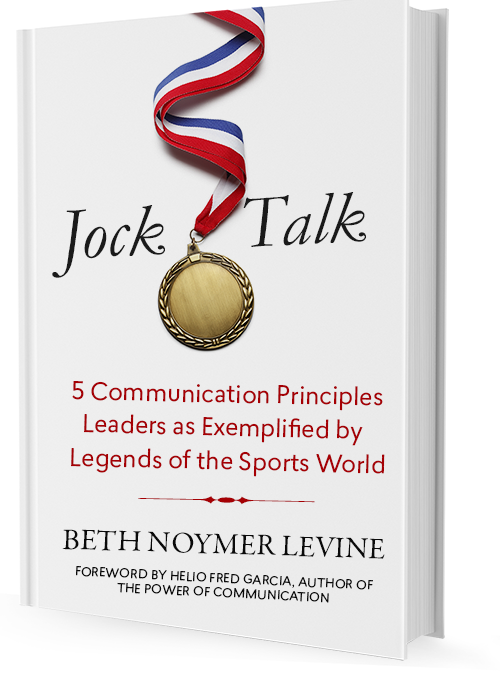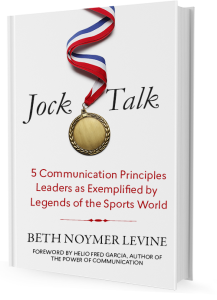by Beth Levine | Sep 4, 2018 | preparing for a presentation, public speaking
Last week, I was strolling the streets of Manhattan, killing time, when I walked by one of those nice stationery stores that sells not only paper, but beautiful cards, planners, and novelty items. I was thinking it was almost time for a 2019 calendar (yes, I still love a paper calendar!) and so I went in to browse.
 The first thing I spotted, on a display table that sat front-and-center, was a stack of small black boxes that said “Stop Talking” on the front. I couldn’t imagine what they were. Luckily, one of the boxes was already opened and so I got a look – inside were 50 or so ivory-colored cards that also said “Stop Talking” in black ink.
The first thing I spotted, on a display table that sat front-and-center, was a stack of small black boxes that said “Stop Talking” on the front. I couldn’t imagine what they were. Luckily, one of the boxes was already opened and so I got a look – inside were 50 or so ivory-colored cards that also said “Stop Talking” in black ink.
This is when my head-scratching began. So, for $9.95, I could have 50 of these little cards to hand out to over-talkers? When would I use these and how? Were these for chatty friends who, over coffee, start answering ‘what’s new?’ and then never come up for air? Were these for those meeting participants who talk for the sake of hearing themselves talk? Were these meant to be surreptitiously slipped onto the desks of neighboring cubicle dwellers who talk too much and too loudly?
My imagination ran wild. And then it stopped. I decided these little “Stop Talking” cards were for any and all of the above … and probably more. We live in a world of talkers, and clearly someone invented this novelty item on the theory that there would be plenty of consumers who would find these “calling cards” amusing and/or useful.
What does this say, then, about how we’re doing with two-way communication? Can you imagine a similar offering of 50 “Stop Listening” cards? I can’t. The problem is that the talking side of the communication see-saw is always over-weighted, and the listening side is under-weighted. Anecdotally, I know this to be the case because I often get asked if I can coach people to be more succinct and to listen better, sometimes teams of people. It’s quite common that people talk more than others can bear, and it’s universally challenging among individuals and groups alike.
For those who are nodding in agreement while reading so far, here are 5 quick-tip reminders about listening versus talking that you can use as refreshers for yourself or that you can share with your favorite over-talker(s):
- Think about your audience: Is this someone/a group you should be listening to more (boss or client) or talking to more? Is there really anyone you should be talking to more than you should be listening to? Balance your talking with listening.
- Train your brain to go into neutral and simply be present and listen. Literally, stop your brain for a minute. Focus. Hear. Process. Listen, stop talking.
- Listen for the purpose of empathizing and relating rather than listening for the purpose of formulating a response. You might not need to formulate a unique response at all, you might just need to reiterate/reinforce/validate what you heard. Slow down. Listen, stop talking.
- Listen for the purpose of learning, gaining insight or gathering intelligence. Listening can produce some very valuable material you can use to your advantage later on. If you’re talking, you’re not learning. Listen, stop talking.
- Listen intently, actively and sincerely. Be that person. So that when you want to talk and be influential, you will surely be given your due. Listen for real, so you when you need to talk, others will listen.
Those “Stop Talking” cards stopped me dead in my tracks and got me thinking. I’m not sure I’d have the gumption to hand them out, but I considered it. More than that, they prompted me to think about communication as a two-way transaction that breaks down when one way gets more traction and time than the other. The fix is simple, though: stop talking so much, start listening more!

by Beth Levine | Aug 13, 2018 | preparing for a presentation, public speaking
It doesn’t take much to be a good leader-communicator. Perfection may be elusive, but being good enough to earn the admiration of your team are well within reach. Adherence to a few core principles takes care of most situations.
 In my book Jock Talk: 5 Communication Principles for Leaders as Exemplified by Legends of the Sports World, I walk readers through the philosophy behind, and application of, these 5 principles: Audience-centricity, Transparency, Graciousness, Brevity, and Preparedness.
In my book Jock Talk: 5 Communication Principles for Leaders as Exemplified by Legends of the Sports World, I walk readers through the philosophy behind, and application of, these 5 principles: Audience-centricity, Transparency, Graciousness, Brevity, and Preparedness.
Taken together, they send two really important messages about you to your audience: 1) that you care about and respect them, and 2) that you’re real and therefore credible and trustworthy.
Audience-centricity is probably the most fundamental of the five principles. Simply put, audience-centricity is making the audience’s interests and experience a top priority in the planning and execution of a talk. Too many speakers prepare and deliver what is important and interesting to themselves without enough careful consideration of their listeners. Being audience-centric is a mindset shift that encourages the speaker to prepare and deliver content in a way that will matter to and resonate with the audience.
Transparency is exactly what you think it is; it’s about being open and direct—yes, and honest, too. Transparency is critical. It contributes to the levels of sincerity and trust that are accorded to you by your audience.
Graciousness is the art, skill, and willingness to be kindhearted, fair, and polite. As motivators and influencers, love and peace work far better than hate and war. Speaking in positives rather than negatives leaves lasting, favorable impressions.
Brevity is a crowd-pleaser and needs no further introduction.
Preparedness speaks for itself as well, especially because the unprepared speaker is the one who is most likely to be longwinded, not to mention unfocused. While the mere thought of preparation might bring on feelings of dread or even impossibility, there are ways to prepare that take only seconds but that can greatly enhance a speaker’s effectiveness.
As summer winds down and everyone settles in for the homestretch toward year-end, I would encourage you to pick one of these principles as your personal pet project for the fall. Which one of these 5 do you feel like you need to improve on the most? Or which one of these 5 would have the most impact on your business if you strengthened it? Pick one and go for it!

by Beth Levine | Jul 31, 2018 | preparing for a presentation, public speaking
“There are always three speeches, for every one you actually gave.
The one you practiced, the one you gave, and the one you wish you gave.”
Dale Carnegie
 This is a daunting thought for overachievers or anyone who strives to do their best at the front of the room!
This is a daunting thought for overachievers or anyone who strives to do their best at the front of the room!
Or not? You might be one of those people who is so relieved to be done with your talk and still have a pulse that you don’t bother to reflect on any of the three, and especially not on the speech you wish you gave.
But you should.
That third one – the speech you wish you gave – is the one that’s most valuable. To you. Your audience is likely fine. The one you gave is the one you practiced, augmented by shots of adrenaline and the energy (or lack thereof) in the room.
It’s the one you wish you gave, though, that is loaded with wisdom for your next turn at the podium. Don’t let 24 hours pass before you give it some thought and, instead of sighing and saying oh well, make some ‘notes to self’:
On Content
Did I open well and grab their attention right away? Would I open differently the next time?
Was every section relevant?
What about the length? Too long/too short?
Did I stray into too much detail in one section while the other sections were more succinct?
Did their questions reveal an interest that was different from the angle I prepared?
What did I wish I had included/excluded?
What are three things I could do to make this content more memorable?
On Delivery
Did I move around and use the floor, or did I stand in one place the whole time?
Did I look at my slides too much (or worse, read them)?
Did my voice have energy, convey passion or dedication to the material?
What about my eye contact in the room? Is that something I could have done better?
Was I able to move forward, toward the audience, giving them the sense that I wanted to be there?
Did I talk too fast? Should I have incorporated some pauses where the audience needed to digest the material?
Making ‘notes to self’ immediately after a talk is one of the simplest ways to help yourself improve as a speaker. Not only are you your own harshest critic, but because you are the source of your own feedback, you’ll understand it completely and you’ll be more motivated to correct it the next time around. The only tricky part is remembering to refer to your notes before you prepare to speak again.

by Beth Levine | Jul 12, 2018 | preparing for a presentation, public speaking
 Communicating effectively is not rocket science (maybe this is why rocket scientists are not known to be great communicators?). It’s rarely considered something that’s terribly complicated or difficult, yet I have spent the better part of a decade and a half “dumbing it down” so that professionals of all types can be more clear, more concise, and more successful at getting their points across to other busy (read: busy-minded) people.
Communicating effectively is not rocket science (maybe this is why rocket scientists are not known to be great communicators?). It’s rarely considered something that’s terribly complicated or difficult, yet I have spent the better part of a decade and a half “dumbing it down” so that professionals of all types can be more clear, more concise, and more successful at getting their points across to other busy (read: busy-minded) people.
The reality is, I’m not actually making it dumber, I’m making it simpler. Less work. Less time. Easier for the speaker (to remember, deliver). Easier for the audience (to pay attention, retain). And the simpler I make it, the more accessible it is to everyone regardless of their level in an organization, and therefore the more widely utilized it is.
On more than a few occasions in the past few months, when I’ve been invited to share my simple framework for communicating effectively, the CEO has been in the room with his or her team for the session. My approach and the SmartMouth methodology have been met with sighs of relief and exclamations of “this is what I have been trying to tell all of you!” In one case, I was met with what could only be described as excitement and joy – clearly, this executive has spent a good bit of time being frustrated with his team’s communication skills.
Since there are a lot of rocket scientists out there – i.e. a lot of smart people with a lot of dense technical knowledge in a variety of fields – I want to share my top 3 pieces of advice for any communicator. You could be a keynote speaker or you could be a participant in a meeting. It doesn’t matter. These 3 are game changers.
1. TMI is the #1 killer.
If I could fix only one thing about how people speak or present, I would attack the “too-much-information syndrome.” In fact, I do attack it, and pretty regularly. Here are some root causes of the problem, see if they sound familiar: presenters who feel the need to prove how smart they are, presenters who love their detail because it fascinates them, presenters who don’t (or can’t?) prioritize their brain dumps, thereby leaving it to their audiences to figure out what’s important.
Information is only valuable and, arguably, relevant when it supports a point. So identify your point first and then pick the information that best supports it (a point is a statement that captures significance or value as a main thought or idea does, or one that summarizes a collection of information). The amount and type of information a speaker chooses to use should be based on the audience – their appetite, their needs/interests, their level of sophistication – not based on what floats the speaker’s boat. If you are sitting with a pile of information that you need to present, ask yourself how you might capture the importance or benefit of all that detail in once sentence and deliver that first, followed by the info.
Finally, less is more. If you can eliminate some information, even better!
2. Serve dessert first.
Life is short, and so are attention spans. Serve dessert, or the point, first. Everything else, like information, is a side dish. Audiences don’t have endless attention to give you, and there are lots of distractions in any given room (some, like devices, give instant gratification when you don’t!). Audiences need a reason, and some context, to hang in there with you.
You can serve dessert first in two ways: First, think about telling your audience upfront what you want them to think, know, do or feel by the end of your talk. And when I say upfront, I mean it’s okay to make this one of your first few sentences – while audience attention is still fresh and on you. You literally can spoon-feed them the impression you hope they’ll take away or the action you hope they’ll take when they leave the room. Second, per the above section on TMI, don’t deliver a truckload of information and then serve up the conclusion; instead, figure out what your conclusion or point is, deliver that first, and then unload your information.
Dessert first!
3. It’s not all about you, it’s about them.
Have empathy! For your audience, that is. Consider the experience you are about to give an audience based on your own experiences. You know what it’s like to sit through a presentation or a talk. You know how often you check out, what you like/don’t like when someone else is at the front of the room, or what visuals you find helpful or enjoyable. Use your own experiences to inform the kind of experience you want to give your audience(s).
No matter how much you love your topic, or no matter how urgent it is that you share your content, think about them – who they are, what they really care about, where they are on the learning curve of your topic, why they’re in the room, and how you might impress them – and then adjust your content accordingly. Their needs and interests are more important than yours. I always say, there’s an unspoken agreement between speaker and audience that, in exchange for their time and attention, you will give them something useful or valuable – which you can determine based on the who, what, where, why and how listed above.
Putting these 3 pieces of advice into practice may take some time, but even just the awareness will help you make some advances in your communication skills and style.

by Beth Levine | Jun 18, 2018 | preparing for a presentation, public speaking
It’s funny when people ask what they should do to emphasize something in their speech or presentation. Seems like, depending on what it is they want to emphasize, they would know best. After all, it’s part of their content, it means something special to them, and it’s their goal or intention to call it out.
 Even though I’m sometimes tempted to snark back, “well, how would YOU LIKE to emphasize it,” I usually offer a menu of options. Not surprisingly, the menu items all have a common ingredient: supersizing. Go big or go home. Whatever they choose to use, it’s got to be bigger, more, louder, better, stronger, or different.
Even though I’m sometimes tempted to snark back, “well, how would YOU LIKE to emphasize it,” I usually offer a menu of options. Not surprisingly, the menu items all have a common ingredient: supersizing. Go big or go home. Whatever they choose to use, it’s got to be bigger, more, louder, better, stronger, or different.
Here are four supersizing options for you to consider using the next time you really want the room to hear it, get it, remember it:
Words. Choose special or unexpected words. Use a killer metaphor. Construct an especially brief sentence. Repeat the words. Repeat the words again. Make a rhyme. Use call and response with your audience.
Energy. Change the energy in your voice or your body. Get louder for a few seconds. Animate with your hands. Move across the floor or stage. Stop and stand still if you’ve been moving. Get on your toes. Move as close to the audience as you can. Throw some theatrics in (note: what feels “theatrical” to you will simply seem “energetic” to the audience).
Pauses. Create a few seconds of anticipation prior to what you want to emphasize. Leave a few seconds for marination following what you want to emphasize. Give your pause a drumroll – for example, “I’m going to pause here because what I have to say next is critical …”. Take a measured pause in. between. each. word. of. the. sentence. you are emphasizing.
Labels. Slap labels on your emphasized content. For example, “If there’s one thing I want you to remember,” “I cannot emphasize enough,” “This cannot be overstated.” Labels warn and wake. They guide and grab.
Help your audience out. Even the best of the best – those audience members who are paying attention – may not catch something you’re trying to emphasize unless you supersize it somehow. Audiences don’t know what you want them to know or remember unless you tell them!
 The first thing I spotted, on a display table that sat front-and-center, was a stack of small black boxes that said “Stop Talking” on the front. I couldn’t imagine what they were. Luckily, one of the boxes was already opened and so I got a look – inside were 50 or so ivory-colored cards that also said “Stop Talking” in black ink.
The first thing I spotted, on a display table that sat front-and-center, was a stack of small black boxes that said “Stop Talking” on the front. I couldn’t imagine what they were. Luckily, one of the boxes was already opened and so I got a look – inside were 50 or so ivory-colored cards that also said “Stop Talking” in black ink.



 This is a daunting thought for overachievers or anyone who strives to do their best at the front of the room!
This is a daunting thought for overachievers or anyone who strives to do their best at the front of the room!
 Communicating effectively is not rocket science (maybe this is why rocket scientists are not known to be great communicators?). It’s rarely considered something that’s terribly complicated or difficult, yet I have spent the better part of a decade and a half “dumbing it down” so that professionals of all types can be more clear, more concise, and more successful at getting their points across to other busy (read: busy-minded) people.
Communicating effectively is not rocket science (maybe this is why rocket scientists are not known to be great communicators?). It’s rarely considered something that’s terribly complicated or difficult, yet I have spent the better part of a decade and a half “dumbing it down” so that professionals of all types can be more clear, more concise, and more successful at getting their points across to other busy (read: busy-minded) people.
 Even though I’m sometimes tempted to snark back, “well, how would YOU LIKE to emphasize it,” I usually offer a menu of options. Not surprisingly, the menu items all have a common ingredient: supersizing. Go big or go home. Whatever they choose to use, it’s got to be bigger, more, louder, better, stronger, or different.
Even though I’m sometimes tempted to snark back, “well, how would YOU LIKE to emphasize it,” I usually offer a menu of options. Not surprisingly, the menu items all have a common ingredient: supersizing. Go big or go home. Whatever they choose to use, it’s got to be bigger, more, louder, better, stronger, or different.

